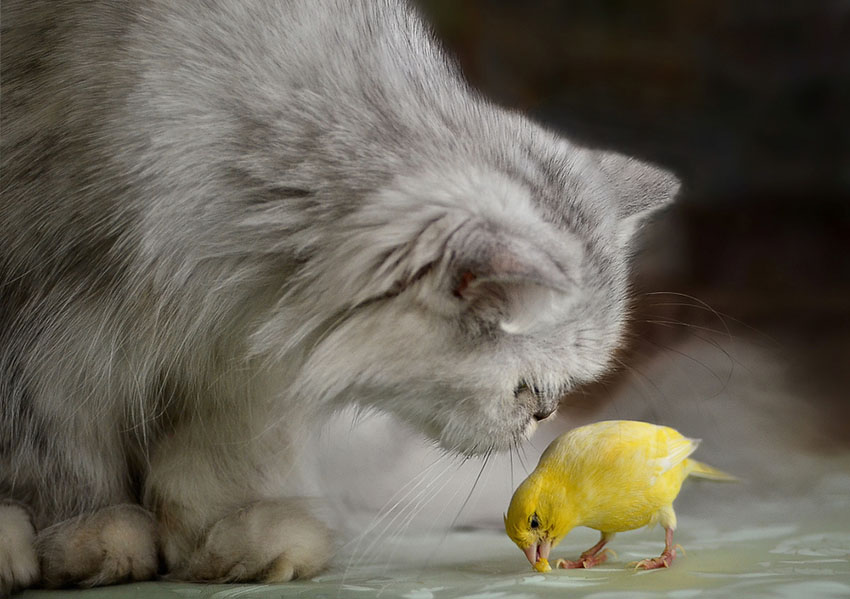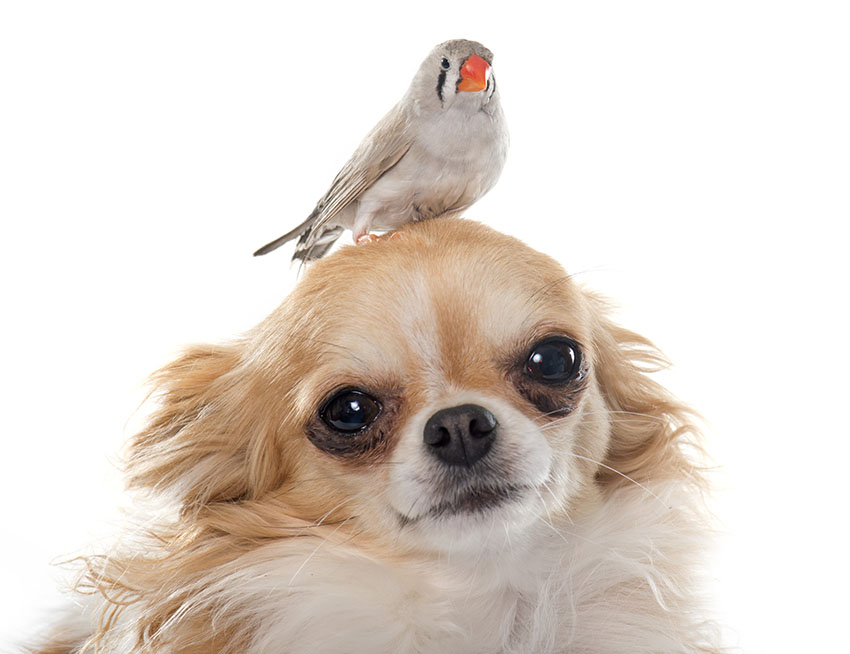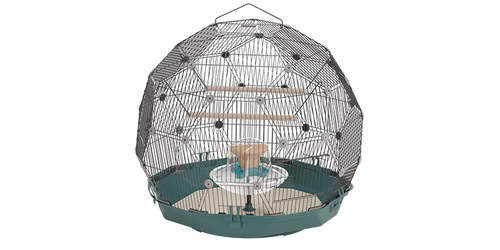Finches will happily live in mixed groups as long as there is sufficient space in the aviary. They will usually live happily with larger birds such as (small) parrots, as long as there is lots of separate perching space to enable the birds to keep their distance.
The proximity of small pets such as rabbits, guinea pigs, hamsters and gerbils will not worry the finches. If your pet Canary is allowed to leave its cage and free-fly in the room, however, it’s best not to let them land on a small mammal's cage, just in case the inhabitants decide to nibble the bird's toes (unlikely as that is).
Finches and Cats
Think of your favourite food, perfectly prepared by a world class chef all served up on a silver platter - this is pretty much how your cat will view your finches. Cats eat birds, and it’s one hell of a struggle trying to teach them not to. Given that most finches will spend their lives in an aviary or a cage, this relationship is not usually something you have to worry about. Keep any cats you may have away from your birds, and discourage them from lunging at the cage.

Cat and finch - it won't usually be like this!
This being said, some owners do allow their pet birds and pet cats intermingle, and a friendship of sorts can be established, sometimes. It all depends on the nature of your cat, any outdoor feline will never be able to form a friendly relationship with your birds. Even if you have a stay-at-home cat that likes to spend their time curled up in your lap snoozing, it will still be hard to form a cat-bird relationship that doesn't end in disaster.
Only you as the owner can judge whether or not your cat will enter killer mode as soon as the birds are let loose. If you are sure that your feline friend won’t immediately try to kill your birds, you can slowly introduce your finches to them by holding them gently in a manner that doesn’t allow flight. Be sure to keep an eye on your cat for any signs that they might be ready to punce or lash out, if they do they should be reprimanded with a harsh NO! Or whatever other form of dissuasion you use. Don’t shout at your cat though, as the raised voices will make your birds nervous. Allow your cat to check out the bird. If you are holding the bird in your hand, the cat will come to associate it with you and treat them with the respect and attention they show you. The end goal here is to be able to let your bird fly freely and java your cat ignore it.
You will never be 100% in control of these first introductory sessions, however. A bird that starts flapping around may bring out your cat’s hunter instinct. Some cats will get it straight away whereas others will never learn, it depends on the cat. This being said, the risk factor can never be fully eliminated.
Your best bet by far is simply not to let your cat interact with your birds. The two animals don’t have to form friendships and if you do let your birds fly freely, you can simply shut your cat in another room. This being said, someone could accidentally open the door letting the cat into the same room as your bird, it is important that everyone knows that your finches are out of the cage.
As is the case with puppies, kittens should never be let near your birds.
Finches and Dogs
Most dogs have an either predator or stick-chasing instinct when they are around, and you will need to restrain them when first introducing your birds. A well trained dog will soon understand that the cage is not to be played with and that they cannot jump or bark at the birds in the cage, no matter how energetic or noisy the finches get. The key is minimising the anxiety in your birds when the dog is exploring them with their nose.

Finches and dogs - the relationship is not as easy as this image suggests!
It is important to make sure you have control over your dog when letting him sniff out the cage. If they start to bark or knock into the cage, calm them down and let them know that the cage can be sniffed, but must not be played with or barked at.
Your dogs will take a great interest in the cage for about a week or so, after that most dogs will get used to it and lose interest, barely raising an ear to acknowledge the twittering and flapping. The exact amount of time it will take for your dogs to lose interest does depend on the breed, though most breeds seem to fall under the week-or-so category.
The finches will grow to ignore the dogs as long as there are bars between the two of them. The only time that a problem could occur is when the cage is knocked or they are barked at from a close vicinity.
As the numerous pictures of dogs with finches perched on their heads or by their sides would suggest, it is indeed possible for your dogs and your birds to form a relationship closer than just mutual ignorance of one another. This is achieved by letting the animals interact outside of the bird's cage. It is important to note that if you plan on trying this, great care needs to be taken to prevent any potentially fatal encounters. Even a dog that is completely used to the birds in the cage will instinctively chase and maybe even snap at a free-flying bird.
Many breeds will never be able to view your birds as anything more than prey. Jack Russels, and any other type of terrier, have been bred to hunt and kill small animals, whether or not those small animals happen to be your pets does not cross their minds. Hundreds of years of selective breeding can’t be ignored simply because you brought home a pet finch. Puppies should also always be kept away from your birds.
If you have an adult, non-hunting, extremely well-trained and passive dog, you might just be able to put the finch on or near them without them reacting, sort of in the same way you can place food on a well-trained dog’s nose without them eating it. If you’re not 100% confident in your dog's training, it’s best not to let the animals meet without the presence of bars separating the two. It is also important that you don’t let your dog lick the finch, as your birds could catch diseases from the saliva.



Comments
There are no comments just yet